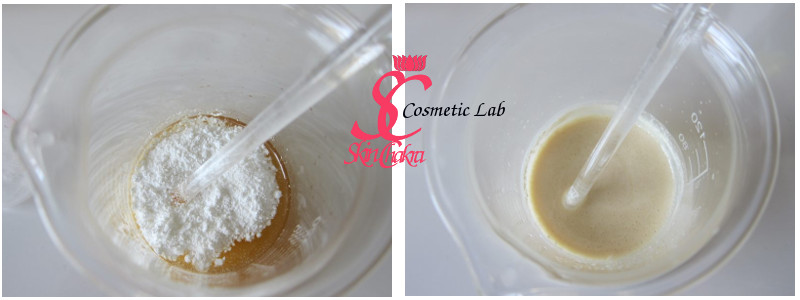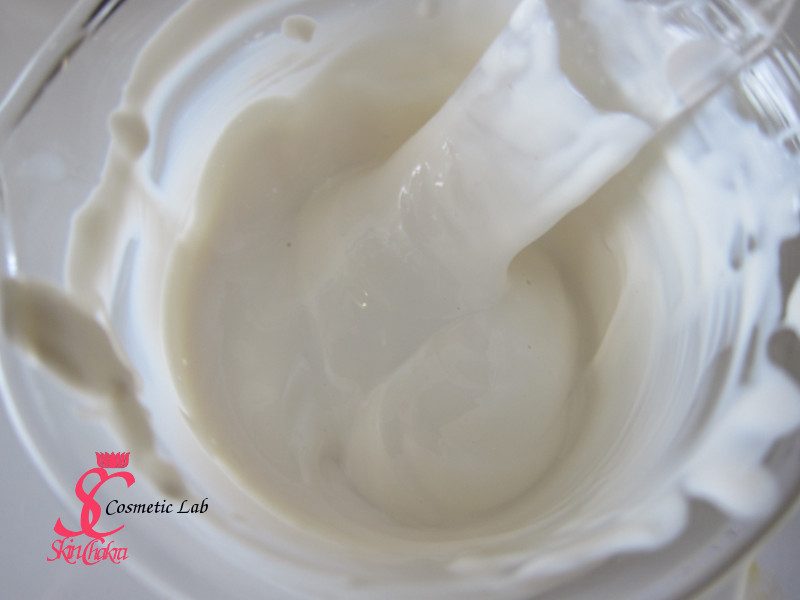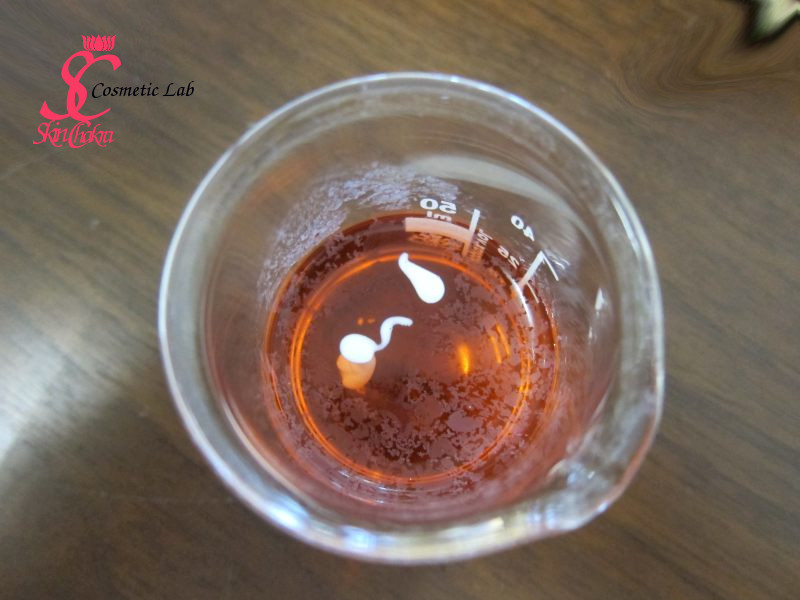
Dienstag, 31. Mai 2016
How to make a cold process night cream
Those of you who have read my previous post about making a W/O emulsion with the skin feel of an O/W emulsion are certainly curious to try more recipes with the amazing cold process and natural W/O emulsifier I've already introduced to you.
Night creams are usually W/O because they offer a long-lasting moisturization and refatting and because what may feel heavy on your skin during the day is quite tolerable and pleasant during the night.
For this night lotion, I've kept to my KISS principle and the formulation is pretty simple but nourishing, anti-inflammatory and soothing. You can even apply it during the day if you like the skin feel, I would certainly apply this during cold and windy winter days when I know I would be outdoors the majority of the time, otherwise, I like it as a night emulsion.
The viscosity of the emulsion is too high for a sprayable emulsion but is both suitable for a lotion pump or application from a jar.
I've added 5.0% Zinc oxide to the lotion, not as a sun protection ingredient but for its amazing skin soothing and healing properties. The rest of the ingredients are pretty simple but effective. Pomegranate seed oil with its wonderful anti-oxidant and anti-aging properties, poppy seed oil which is one of my favourite oils for dry skin, evening promrose oil with its outstanding anti-inflammatory properties. I've added yarrow hydroglyceric extract and calendula extract in jojoba oil which might sound quite boring but is pretty effective.
With this cold process emulsifier, you can pack all your sensitive oils and extracts into the emulsion because you're working at room temperature. It doesn't mean however, you can not apply this emulsifier with butters and solid oils. It works perfectly as a hot-process emulsifier as well.
The key point in working with this emulsifier blend is the slow addition of the water phase to the oil phase. Add the water little by little and completely blend before adding the next aliquote.
Another important point is the pH adjustment. For W/O emulsions, the pH should be adjusted for the water phase and before you blend the water and oil phase. There is no chance of measuring and adjusting the pH of an W/O emulsion after the emulsion is formed.
Now let's go to the practical part.
As always before we start I want to recommend you to read our older posts: hygienic manufacturing practice in cosmetic lab and introduction to Basic equipments and utensils for a cosmetic lab.
Ingredients:
| Phase A | |
| Witch hazel hydrosol | to 100.0% |
| MgSo4 | 0.5% |
| Allantoin | 0.1% |
| Panthenol | 0.5% |
| Sodium lactate | 2.0% |
| Vegeluron | 4.0% |
| Hydroglyceric yarrow extract | 2.0% |
| Dermosoft 1388 eco | 2.0% |
| Dermofeel PA-3 | 0.1% |
| Lactic acid 80% | a few drops |
| Phase B | |
| organic poppy seed oil | 6.0% |
| organic pomegranate seed oil | 3.0% |
| organic evening primrose oil | 3.0% |
| Calendula extract in organic jojoba oil | 5.0% |
| Symbiomuls WO | 9.5% |
| Rosemary CO2 Extract | 0.1% |
| antimicrobial plant extract | 0.1% |
| Olive squalane | 2.0% |
| alpha-bisabolol | 0.2% |
| Euxyl K903 | 0.5% |
| Tocopherol | 0.5% |
| Phase C | |
| ZnO | 5.0% |
| Phase D | |
| Ylang-Ylang EO | 0.2% |
| Manuka EO | 0.1% |
| Patchouli EO | 0.2% |
| Cedarwood EO | 0.1% |
Procedure:
1- Blend all of the ingredients in phase A (except lactic acid) at room temperature. IN our case, the pH of the water phase was around 6 which we reduced to 5.00 by adding lactic acid. If by any chance the pH in your case is lower than 5, then increase it by adding either NaOH or sodium bicarbonate and if the pH is between 5.0-5.5 then lucky you. Don't change the pH at all.
2- Blend the ingredients of the oil phase in a nother beaker. Symbiomuls WO is a thick paste but unless your lab has arctic temperatures it easily blends with the oil phase without any need to warm it. If it remains rock hard however, slightly heat it in a water bath at ca. 40 degrees.
3- Blend the zinc oxide into the oil phase. We dispersed it easily with a spatula. It blends very easily into the oil phase.
4- Slowly and in small aliquotes add the water phase to teh oil phase. Blend completely before adding the next aliquote. Avoid formation of any water pool in the beaker. After all water phase is added to teh oil phase, homogenize the blend for 1-4 minutes depending on your batch size and homogenizer.
The emulsion remains pretty luxurious despite the deep colour of the evening primrose oil and calendula extract.
5- Add the essential oils and blend.
6- You can check the true nature of your emulsion (W/O or O/W) by dispersing a few grams of the emulsion into water and using either a water soluble or an oil soluble colorant to identify the nature of the emulsion. In our case, we used a water soluble color and as you see, the emulsion doesn't blend at all with the coloured water.
I hope you'll enjoy making and trying this nice emulsion.
Feel free to send me your questions, comments and photos. I really enjoy your participation in our Facebook discussions.




